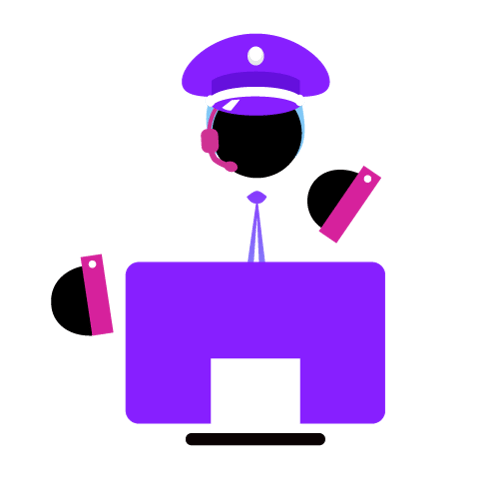Why Your Contact Center Needs to Develop a Serious Case of Multiple Personalities
Tell me if this sounds familiar: Over the past year, you’ve found yourself taking on a growing number of roles—homeschooler, triage nurse, worker bee, video star, therapist, cook, boss, referee, entertainer, IT troubleshooter, and so much more. Well, contact centers these days face the same challenge—they’re being forced to wear multiple hats. To be many things to many people.

Catching Up to a Changing World
Consumers have permanently altered how they live, work, and shop. And while customer service remains a huge deal in businesses’ success, how it’s delivered has changed dramatically.
With customer behaviors and expectations rapidly evolving, contact centers must become experts in customer experience management. It’s simple: Contact centers are challenged to do more and be more than ever before. They have to wear a variety of hats in the world of customer experience.
Imagine someone baaaaaaaalancing a stack of hats precariously atop their head. Or, if you prefer, a multi-headed figure, each head sporting a different hat—and each one representing a different role. That’s the modern-day contact center.
Understanding these roles and making sure they’re filled in a way that contributes to the whole company’s success is vital.
We want to share this toolkit that equips contact center leaders with what they need to evaluate where they are, build partnerships within the company, find opportunities for extraordinary engagements, see the possibilities that technology offers, overcome skills gaps, and deliver incredible value. Check out the toolkit’s activities, checklists, and self-assessments—they’ll help set up your contact center to thrive today and in the future.
In the meantime, let’s take a look at some of the roles that contact centers have to play within the organization. For each one, we’ll also suggest some key questions that will help you home in on areas of challenge and opportunity.

The Provider
Of course, a contact center’s most prominent role is to whip up a full-course meal—take a dash of excellent customer service, add a pinch of answering questions, stir in the ability to quickly and effectively resolve customer problems, and—voila!—you’ve got a recipe for success.
Contact centers are expected to fulfill customer demands, and to balance that with cost-effectiveness. At the same time, they must ensure that the right information is served up consistently across all contacts and contact center channels.
Possible questions:
- Is customer service always on the menu when customers need help? What opportunities are missed? What are the alternatives?
- Can customers get help consistently on the channels most convenient for them? How can the contact center be more available to serve?
- Do customers always receive consistent, accurate answers to their questions? Why or why not?
The Listener
Ho-ho-hold the phone! Because they interact directly with customers, contact centers often have the best idea of what customers want or need or prefer. They have to listen closely for sometimes unexpected feedback and then make a “list” that helps them organize and share what they learn with the stakeholders who need to know.
Additionally, however customer feedback might arrive—by phone, by text, maybe in a letter addressed to “The North Pole”—the contact center is often responsible for taking it in and making amends where appropriate.
By listening to customers and delivering what they want, the contact center puts a smile on both customers’ and colleagues’ faces. Jolly good!
Possible questions:
- Are agents trained to recognize comments made in passing, without the customer using the word “feedback” or “complaint”? How can this skill be developed?
- Do agents have a central place to store unexpected customer feedback? How do you organize and act on this information? Does it get to the person who can take action?
- When problems occur, are agents empowered to make it right, offer fair compensation, and prevent the problem from recurring without seeking special approval? How is this process tracked and managed? How can it be improved?


The Advocate
Because not all parts of the organization share the contact center’s appreciation for customer ideas and frustrations, there are times when the contact center has to speak on the customer’s behalf—to present the case for their “client’s” interests and persuade coworkers of how their actions impact the customer.
Of course, contact center leaders must also build trust and mutual respect with their counterparts across the organization to earn the right to advocate on customers’ behalf. Once that trust is established, the contact center is ready to represent the customer—minus the itchy barrister's wig, of course.
Possible questions:
- Do contact center managers have strong relationships with other groups that serve the customer? How can they be strengthened?
- Do other departments respect feedback about their operation when it comes through the contact center? How can you build rapport?
- Does contact center leadership speak on behalf of the customer without personal bias or conflict of interest? Do outside stakeholders agree? How can trust be improved?
The Fall Guy
When things blow up in other parts of the organization, contact centers have to brace for the falling debris. That’s because customers don’t directly call production, distribution, or quality departments when products are delayed or damaged; they turn to the contact center to get the problem straightened out.
What’s more, the costs of failures often show up in contact center budgets and force them to be the squeaky wheel, even when they’re not at fault.
It’s vital that the contact center roll up its sleeves and get to work doing what's necessary to make sure that customer service and customer satisfaction stay strong, even when things go wrong.
Possible questions:
- Are contact center agents trained to take on responsibility for failures on behalf of the company—or do they commiserate with customers? How can we create positive conversations?
- Do agents see progress toward eliminating the root cause of problems that frustrate customers? Would better communication build their confidence in the brand?
- Is sufficient time allowed for mental breaks and self-care so that agents always have a fresh face for the customer? How are their collective attitudes measured and managed?
- Does the contact center track resolution of service failures on behalf of other business units? Are costs quantified and shared? Is this data used to build business cases for improvement?


The Organizer
Ten-hut! Listen up, folks—contact centers face a major mission when it comes to the customer experience and relationships across the organization: to take the lead on experience enhancements.
To gain control over their workload and costs, contact center leaders must marshal their forces within the organization to reduce points of failure and make things as frictionless as possible for customers. Getting everyone on board and working for the same goal is a medal-worthy strategy.
Possible questions:
- Who in your organization bears ultimate responsibility for the customer? Are they within the contact center or another unit? How can you gain clarity and create accountability if it doesn’t exist?
- What organization-wide initiative would have the most significant impact on reducing contact center costs? What steps are underway to achieve it?
- Does the contact center have access to customer insights from other parts of the organization? Who owns this information? How can it be obtained and leveraged?
Now That's What We Call Sartorial Splendor
Bottom line, a successful contact center must wear many hats—and it has to look good in every one of them.
The traditional contact center approach will always play a vital role in the world of commerce. But it’s time to catch up to where customers are now—and for contact centers to rethink their role within an organization.
As online, in-store, and remote experiences explode in popularity, businesses need a single force—the contact center—to unite the company, direct focus toward the customer, and orchestrate communication and service delivery.
To get more insights, please check out our full report, “Achieving Expectations: Exploring a New Era of Customer Behaviors, Opportunities, and Engagements.”
